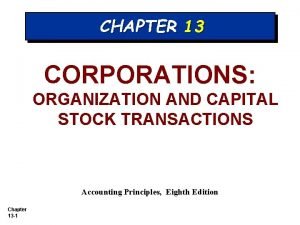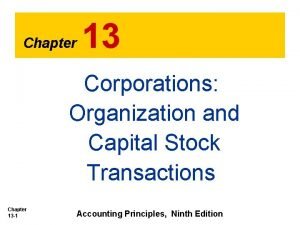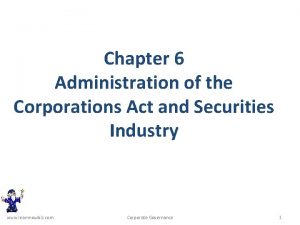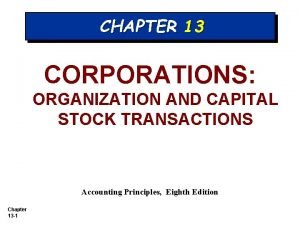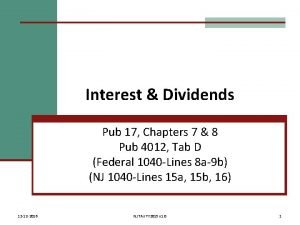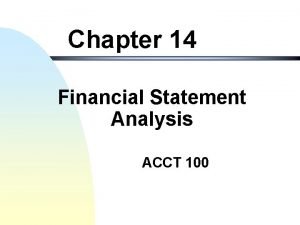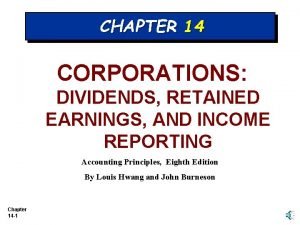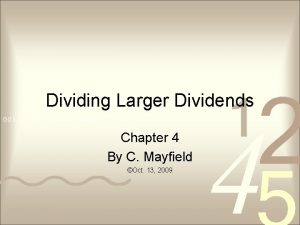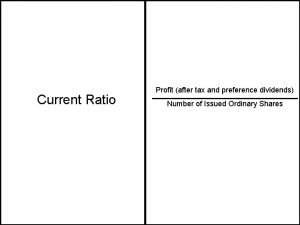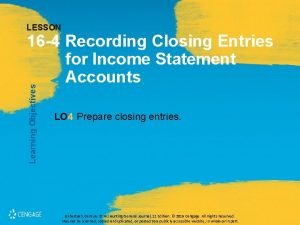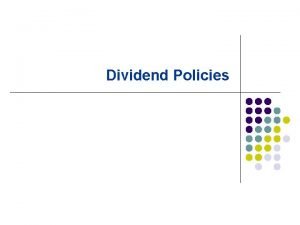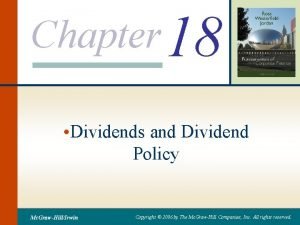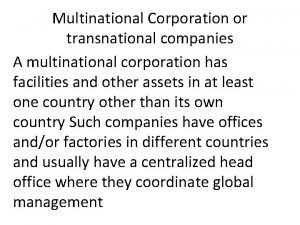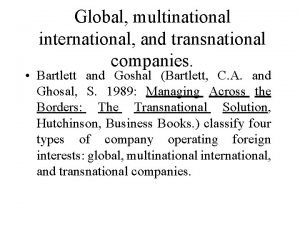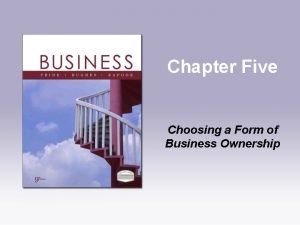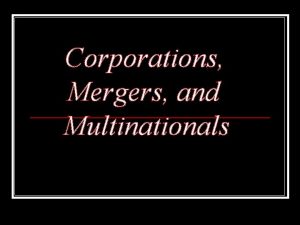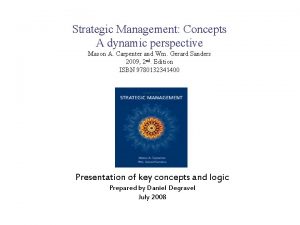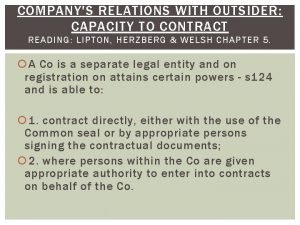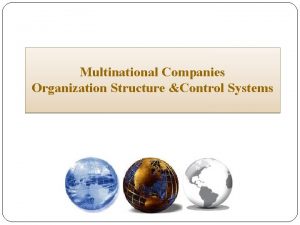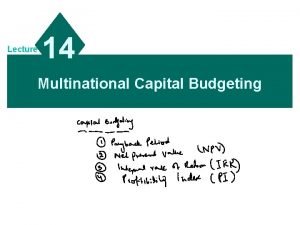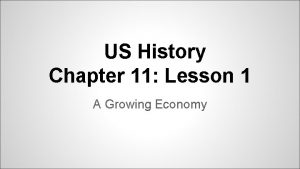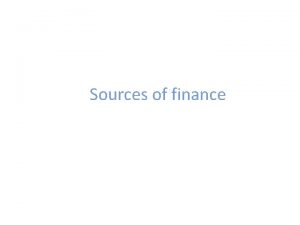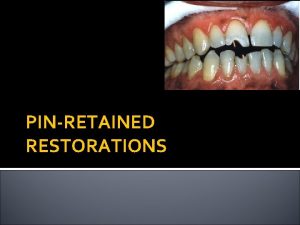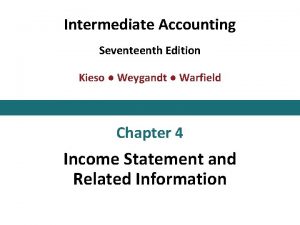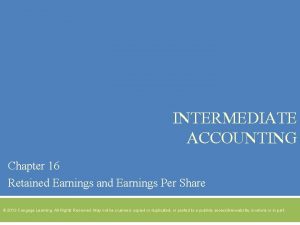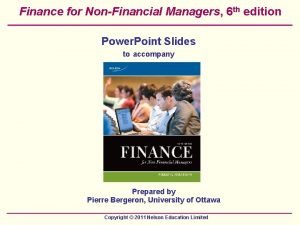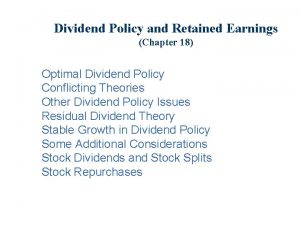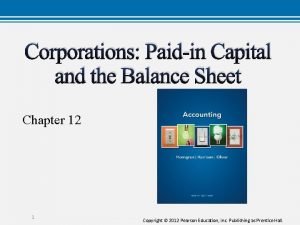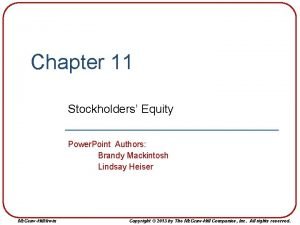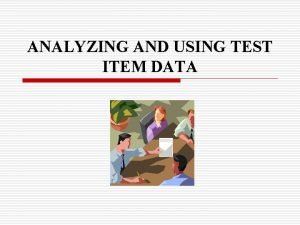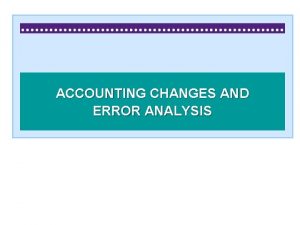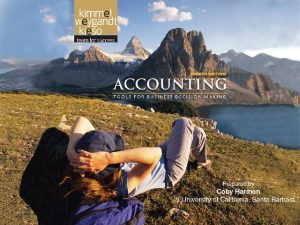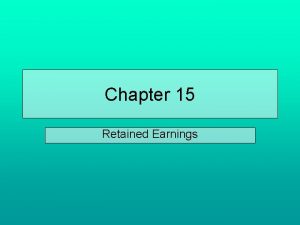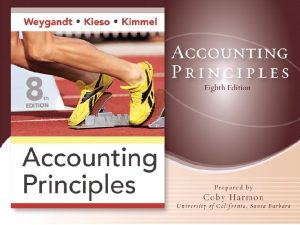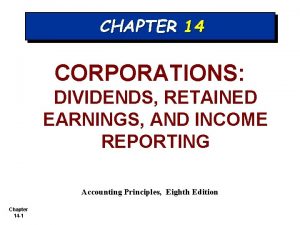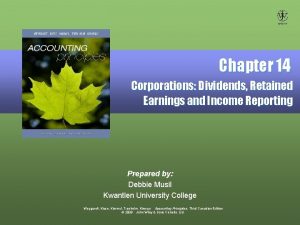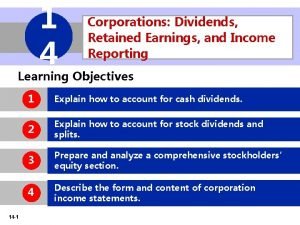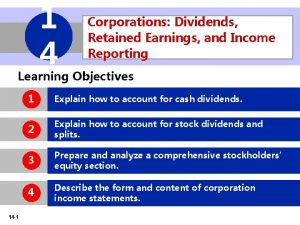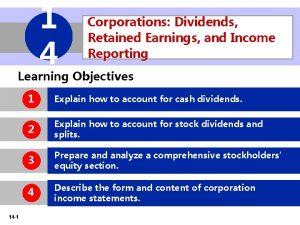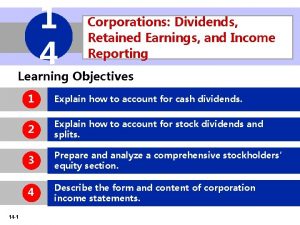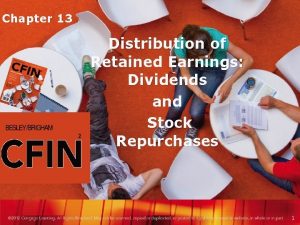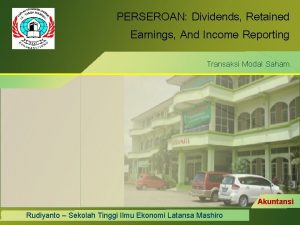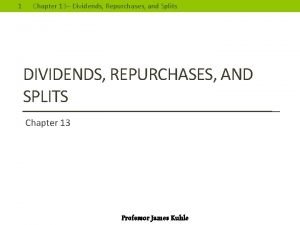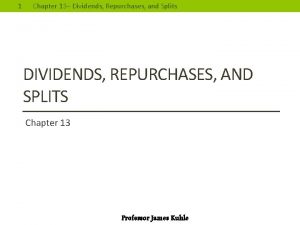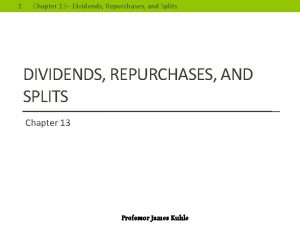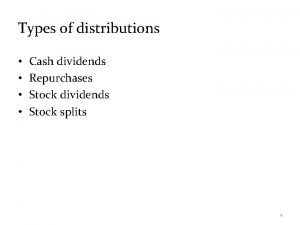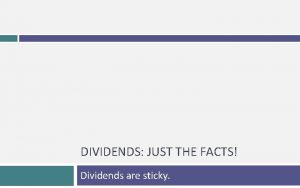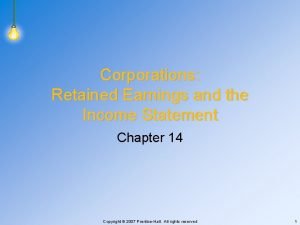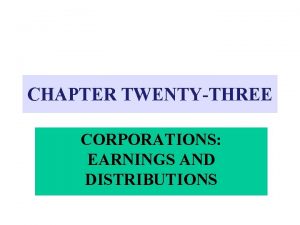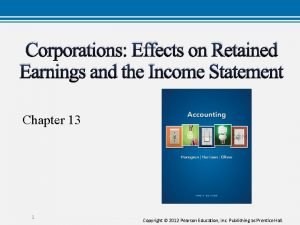Chapter 14 1 Chapter 14 Corporations Dividends Retained






































- Slides: 38

Chapter 14 -1

Chapter 14 Corporations: Dividends, Retained Earnings, and Income Reporting Chapter 14 -2 Accounting Principles, Ninth Edition

Study Objectives 1. Prepare the entries for cash dividends and stock dividends. 2. Identify the items reported in a retained earnings statement. 3. Prepare and analyze a comprehensive stockholders’ equity section. 4. Describe the form and content of corporation income statements. 5. Compute earnings per share. Chapter 14 -3

Corporations: Dividends, Retained Earnings, and Income Reporting Dividends Cash dividends Stock splits Chapter 14 -4 Retained Earnings Retained earnings restrictions Prior period adjustments Retained earnings statement Statement Presentation and Analysis Stockholders’ Equity Presentation Stockholders’ Equity Analysis Income Statement Presentation Income Statement Analysis

Dividends A distribution of cash or stock to stockholders on a pro rata (proportional) basis. Types of Dividends: 1. Cash dividends. 3. Stock dividends. 2. Property dividends. Dividends expressed: (1) as a percentage of the par or stated value, or (2) as a dollar amount per share. Chapter 14 -5 SO 1 Prepare the entries for cash dividends and stock dividends.

Dividends require information concerning three dates: Chapter 14 -6 SO 1 Prepare the entries for cash dividends and stock dividends.

Dividends Cash Dividends For a corporation to pay a cash dividend, it must have: 1. Retained earnings - Payment of cash dividends from retained earnings is legal in all states. 2. Adequate cash. 3. A declaration of dividends by the Board of Directors. Chapter 14 -7 SO 1 Prepare the entries for cash dividends and stock dividends.

Dividends Illustration: On Dec. 1, the directors of Media General declare a 50¢ per share cash dividend on 100, 000 shares of $10 par value common stock. The dividend is payable on Jan. 20 to shareholders of record on Dec. 22? December 1 (Declaration Date) Retained earnings Dividends payable December 22 (Date of Record) 50, 000 No entry January 20 (Payment Date) Dividends payable Cash Chapter 14 -8 50, 000 SO 1 Prepare the entries for cash dividends and stock dividends.

Dividends Allocating Cash Dividends Between Preferred and Common Stock Holders of cumulative preferred stock must be paid any unpaid prior-year dividends before common stockholders receive dividends. Chapter 14 -9 SO 1 Prepare the entries for cash dividends and stock dividends.

Dividends Illustration: On December 31, 2010, IBR Inc. has 1, 000 shares of 8%, $100 par value cumulative preferred stock. It also has 50, 000 shares of $10 par value common stock outstanding. At December 31, 2010, the directors declare a $6, 000 cash dividend. Prepare the entry to record the declaration of the dividend. Retained earnings 6, 000 Dividends payable 6, 000 Pfd Dividends: 1, 000 shares x $100 par x 8% = $8, 000 Chapter 14 -10 SO 1 Prepare the entries for cash dividends and stock dividends.

Dividends Illustration: At December 31, 2011, IBR declares a $50, 000 cash dividend. Show the allocation of dividends to each class of stock. $ 50, 000 2, 000 8, 000 $ 40, 000 ** * * 1, 000 shares x $100 par x 8% = $8, 000 ** 2010 Pfd. dividends $8, 000 – declared $6, 000 = $2, 000 Chapter 14 -11 SO 1 Prepare the entries for cash dividends and stock dividends.

Dividends Illustration: At December 31, 2011, IBR declares a $50, 000 cash dividend. Prepare the entry to record the declaration of the dividend. Retained earnings Dividends payable Chapter 14 -12 50, 000 SO 1 Prepare the entries for cash dividends and stock dividends.

Chapter 14 -13

Dividends Stock Dividends Illustration 14 -3 Pro rata distribution of the corporation’s own stock. Results in decrease in retained earnings and increase in paid-in capital. Chapter 14 -14 SO 1 Prepare the entries for cash dividends and stock dividends.

Dividends Stock Dividends Reasons why corporations issue stock dividends: 1. To satisfy stockholders’ dividend expectations without spending cash. 2. To increase the marketability of the corporation’s stock. 3. To emphasize that a portion of stockholders’ equity has been permanently reinvested in the business. Chapter 14 -15 SO 1 Prepare the entries for cash dividends and stock dividends.

Dividends Size of Stock Dividends Small stock dividend (less than 20– 25% of the corporation’s issued stock, recorded at fair market value) * Large stock dividend (greater than 20– 25% of issued stock, recorded at par value) * This accounting is based on the assumption that a small stock dividend will have little effect on the market price of the outstanding shares. Chapter 14 -16 SO 1 Prepare the entries for cash dividends and stock dividends.

Dividends Illustration: HH Inc. has 5, 000 shares issued and outstanding. The per share par value is $1, book value $32 and market value is $40. 10% stock dividend is declared Retained earnings (5, 000 x 10% x $40) Common stock dividends distributable Additional paid-in capital 20, 000 500 19, 500 Stock issued Common stock div. distributable Common stock (5, 000 x 10% x $1) Chapter 14 -17 500 SO 1 Prepare the entries for cash dividends and stock dividends.

Dividends Stockholders’ Equity with Dividends Distributable Chapter 14 -18 SO 1 Prepare the entries for cash dividends and stock dividends.

Dividends Effects of Stock Dividends $ Chapter 14 -19 0 SO 1 Prepare the entries for cash dividends and stock dividends.

Dividends Question Which of the following statements about small stock dividends is true? a. A debit to Retained Earnings for the par value of the shares issued should be made. b. A small stock dividend decreases total stockholders’ equity. c. Market value per share should be assigned to the dividend shares. d. A small stock dividend ordinarily will have no effect on book value per share of stock. Chapter 14 -20 SO 1 Prepare the entries for cash dividends and stock dividends.

Dividends Question In the stockholders’ equity section, Common Stock Dividends Distributable is reported as a(n): a. deduction from total paid-in capital and retained earnings. b. current liability. c. deduction from retained earnings. d. addition to capital stock. Chapter 14 -21 SO 1 Prepare the entries for cash dividends and stock dividends.

Dividends Stock Split Reduces the market value of shares. No entry recorded for a stock split. Decrease par value and increase number of shares. Chapter 14 -22 SO 1 Prepare the entries for cash dividends and stock dividends.

Dividends Illustration: HH Inc. has 5, 000 shares issued and outstanding. The per share par value is $1, book value $32 and market value is $40. 2 for 1 Stock Split No Entry -- Disclosure that par is now $. 50 and shares outstanding are 10, 000. Chapter 14 -23 SO 1 Prepare the entries for cash dividends and stock dividends.

Chapter 14 -24

Dividends Effects of Stock Splits Chapter 14 -25 SO 1 Prepare the entries for cash dividends and stock dividends.

Retained Earnings Retained earnings is net income that a company retains for use in the business. Net income increases Retained Earnings and a net loss decreases Retained Earnings. Retained earnings is part of the stockholders’ claim on the total assets of the corporation. A debit balance in Retained Earnings is identified as a deficit. Chapter 14 -26 SO 2 Identify the items reported in a retained earnings statement.

Retained Earnings Restrictions can result from: 1. Legal restrictions. 2. Contractual restrictions. 3. Voluntary restrictions. Companies generally disclose retained earnings restrictions in the notes to the financial statements. Chapter 14 -27 SO 2 Identify the items reported in a retained earnings statement.

Prior Period Adjustments Corrections of Errors Result from: mathematical mistakes Ø mistakes in application of accounting principles Ø oversight or misuse of facts Ø Corrections treated as prior period adjustments Adjustment made to the beginning balance of retained earnings Chapter 14 -28 SO 2 Identify the items reported in a retained earnings statement.

Prior Period Adjustments Before issuing the report for the year ended December 31, 2010, you discover a $50, 000 error (net of tax) that caused the 2009 inventory to be overstated (overstated inventory caused COGS to be lower and thus net income to be higher in 2009. Would this discovery have any impact on the reporting of the Statement of Retained Earnings for 2010? Chapter 14 -29 SO 2 Identify the items reported in a retained earnings statement.

Retained Earnings Statement Chapter 14 -30 SO 2 Identify the items reported in a retained earnings statement.

Retained Earnings Statement The company prepares the statement from the Retained Earnings account. Illustration 14 -13 Chapter 14 -31 SO 2 Identify the items reported in a retained earnings statement.

Retained Earnings Statement Question All but one of the following is reported in a retained earnings statement. The exception is: a. cash and stock dividends. b. net income and net loss. c. some disposals of treasury stock below cost. d. sales of treasury stock above cost. Chapter 14 -32 SO 2 Identify the items reported in a retained earnings statement.

Statement Analysis and Presentation Illustration 14 -15 Chapter 14 -33 SO 3 Prepare and analyze a comprehensive stockholders’ equity section.

Statement Analysis and Presentation Stockholders’ Equity Analysis Return on Common Stockholders’ Equity = Net Income Available to Common Stockholders Average Common Stockholders’ Equity This ratio shows how many dollars of net income the company earned for each dollar invested by the stockholders. Chapter 14 -34 SO 3 Prepare and analyze a comprehensive stockholders’ equity section.

Statement Analysis and Presentation Income Statement Presentation Chapter 14 -35 Illustration 14 -17 SO 4 Describe the form and content of corporation income statements.

Statement Analysis and Presentation Income Statement Analysis Earnings Per Share = Net Income minus Dividends Preferred Weighted-Average Common Shares Outstanding This ratio indicates the net income earned by each share of outstanding common stock. Chapter 14 -36 SO 5 Compute Earnings Per Share.

Statement Analysis and Presentation Question The income statement for Nadeen, Inc. shows income before income taxes $700, 000, income tax expense $210, 000, and net income $490, 000. If Nadeen has 100, 000 shares of common stock outstanding throughout the year, earnings per share is: a. $7. 00. b. $4. 90. ($490, 000 / 100, 000 = $4. 90) c. $2. 10. d. No correct answer is given. Chapter 14 -37 SO 5 Compute Earnings Per Share.

Copyright “Copyright © 2009 John Wiley & Sons, Inc. All rights reserved. Reproduction or translation of this work beyond that permitted in Section 117 of the 1976 United States Copyright Act without the express written permission of the copyright owner is unlawful. Request for further information should be addressed to the Permissions Department, John Wiley & Sons, Inc. The purchaser may make back-up copies for his/her own use only and not for distribution or resale. The Publisher assumes no responsibility for errors, omissions, or damages, caused by the use of these programs or from the use of the information contained herein. ” Chapter 14 -38
 Learnnowbiz
Learnnowbiz Accounting for corporations chapter 13
Accounting for corporations chapter 13 Corporate capital
Corporate capital Chapter 6 corporations act
Chapter 6 corporations act Issued common stock for cash journal entry
Issued common stock for cash journal entry Private activity bond interest dividends
Private activity bond interest dividends Dividends of workplace diversity
Dividends of workplace diversity Record date for dividend
Record date for dividend Where is preferred dividends on financial statements
Where is preferred dividends on financial statements Journal entries for stock dividends
Journal entries for stock dividends How can i divide larger dividends
How can i divide larger dividends Net profit after tax and preference dividends
Net profit after tax and preference dividends Record the closing entry for dividends.
Record the closing entry for dividends. Homemade dividend example
Homemade dividend example Compromise dividend policy
Compromise dividend policy Multinational vs transnational
Multinational vs transnational Transnational multinational global international
Transnational multinational global international Disadvantages of corporations
Disadvantages of corporations Corporations mergers and multinationals
Corporations mergers and multinationals What is meant by multinational company
What is meant by multinational company Strategic management a dynamic perspective
Strategic management a dynamic perspective Types of corporations
Types of corporations S198a corporations act
S198a corporations act Karakteristik perusahaan multinasional
Karakteristik perusahaan multinasional Transnational corporations definition
Transnational corporations definition Input for multinational capital budgeting
Input for multinational capital budgeting Corporations developed rapidly in the 1830s
Corporations developed rapidly in the 1830s Characteristics of corporations
Characteristics of corporations Advantages of retained earnings
Advantages of retained earnings Pin-retained composite restoration
Pin-retained composite restoration Income statement discontinued operations
Income statement discontinued operations Intermediate accounting chapter 16
Intermediate accounting chapter 16 Retained earnings ifrs
Retained earnings ifrs Retained earnings in accounting
Retained earnings in accounting Retained earnings vs capital
Retained earnings vs capital Par stock
Par stock When do we retain revise or reject an item
When do we retain revise or reject an item Slide error accounting
Slide error accounting Retained earnings ifrs
Retained earnings ifrs

